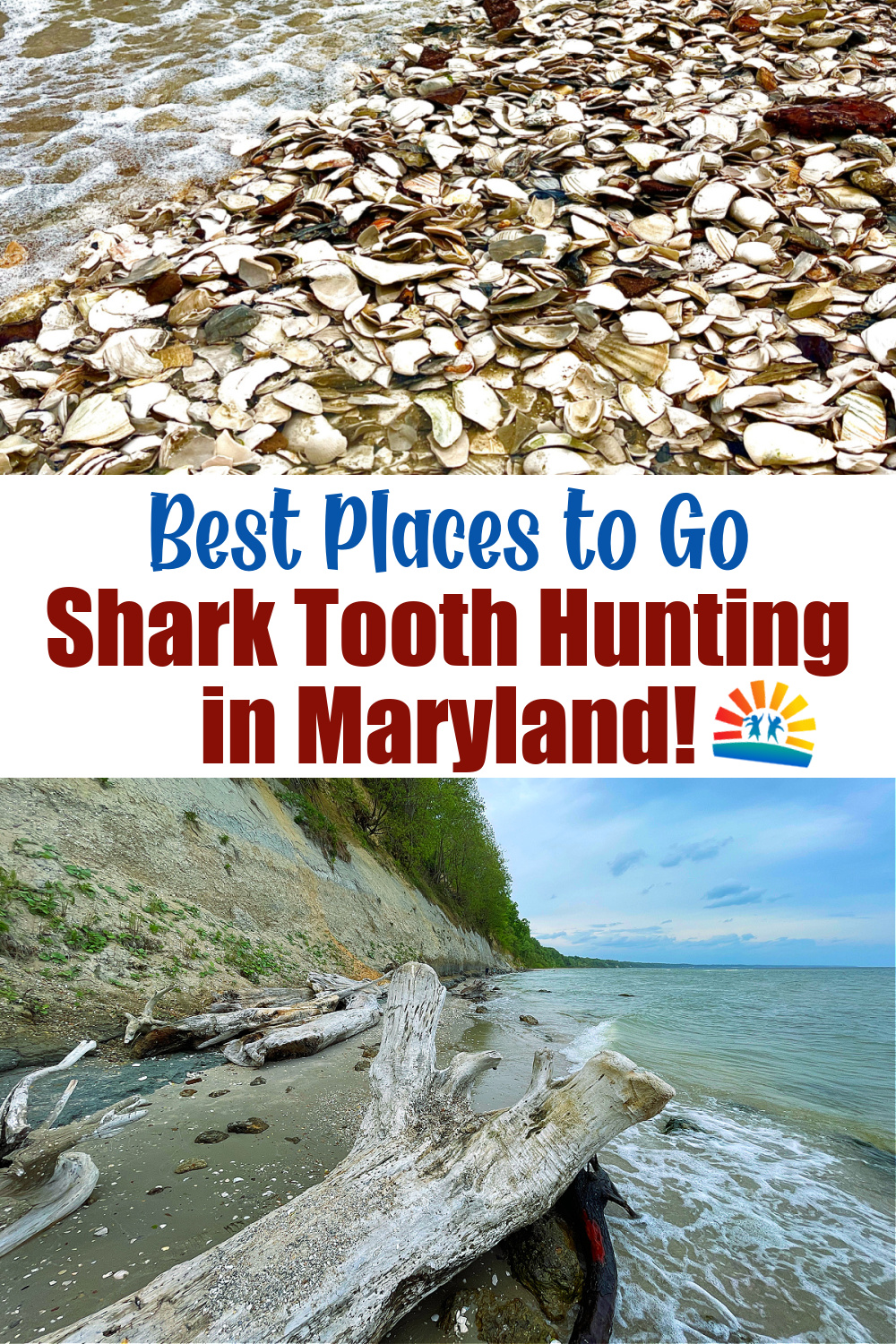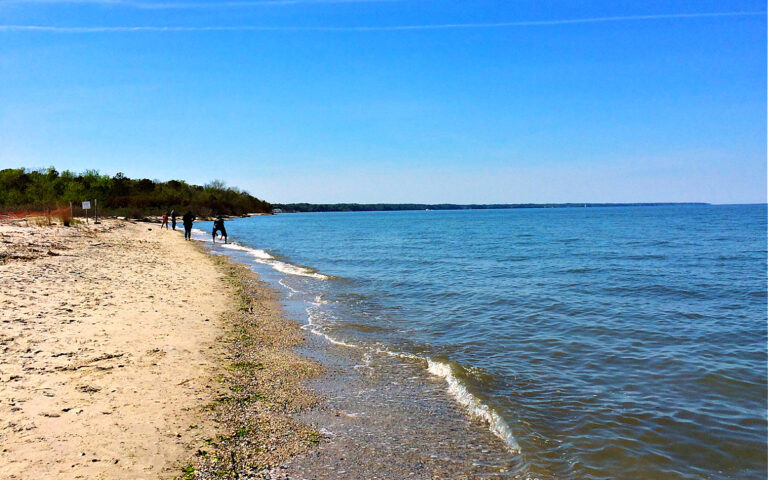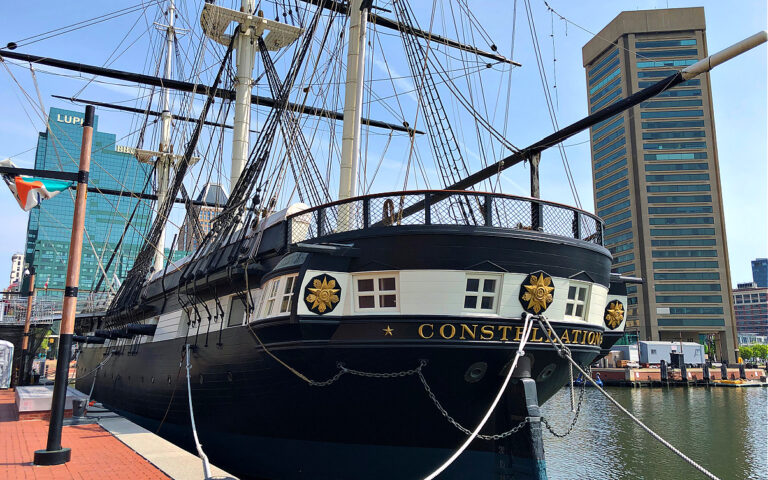Best Places To Go Shark Tooth Hunting in Maryland!
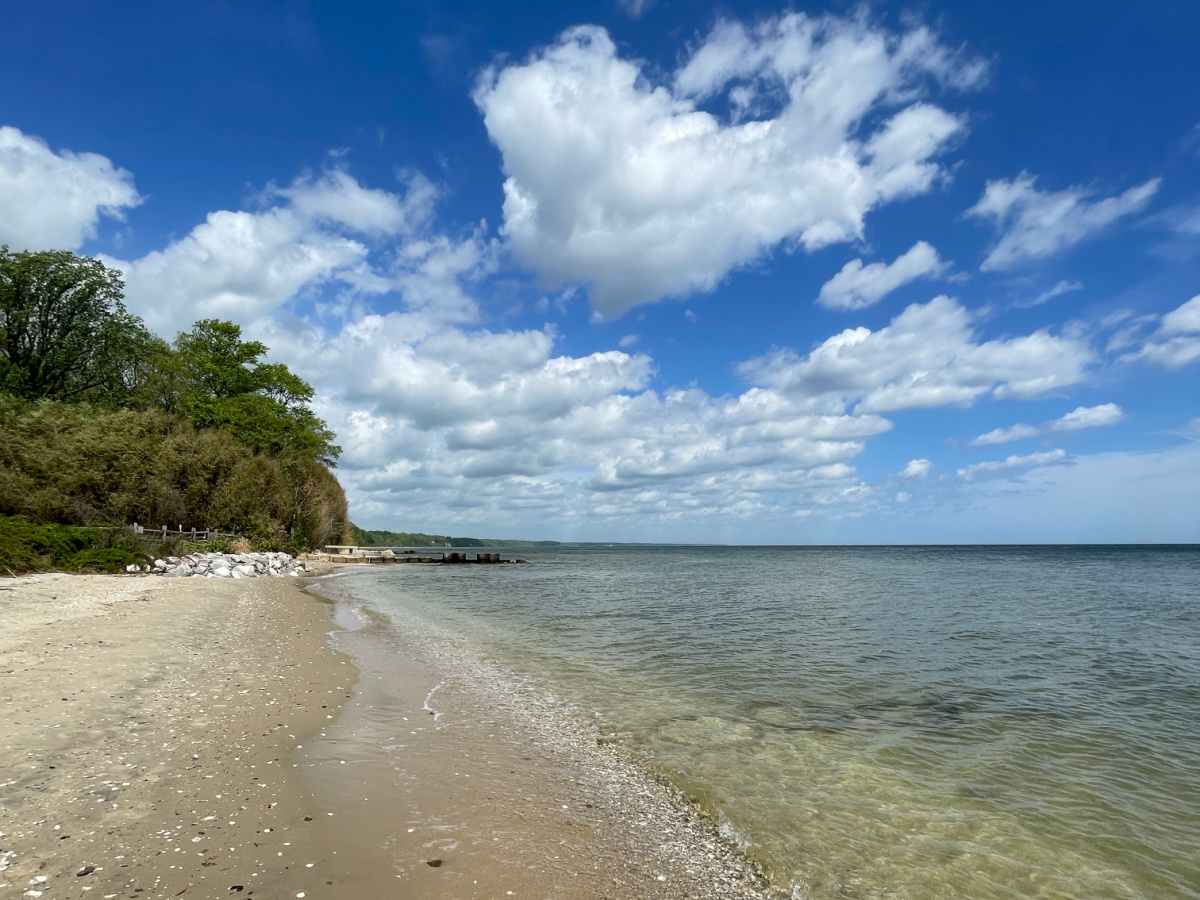
One of the best day trip ideas ever is to go shark tooth hunting in Maryland! This is a fantastic activity that is well suited for people of all ages and your kids will love treasure hunting along the Chesapeake Bay coast. Check out this guide to learn more about why the Chesapeake is a great place to hunt for shark teeth, tips to maximize your trip, and where to go for your fossil finding day trip!

Related: Best Chesapeake Beaches in Maryland for Day Trip Fun!
Why is the Chesapeake Bay a great place to hunt for shark teeth?
Millions of years ago, during the Miocene Epoch, the Chesapeake Bay area of Maryland looked a lot different than it does now. Namely, it was underwater.
The climate was warmer (think North or South Carolina) and the bay was home to thousands of aquatic life like ancient dolphins, giant rays, and huge sharks– including an ancient Great White Shark, which was the apex predator at the time.
Many paleontologists believe this area was actually the calving ground for these sharks, as well as many other animals.
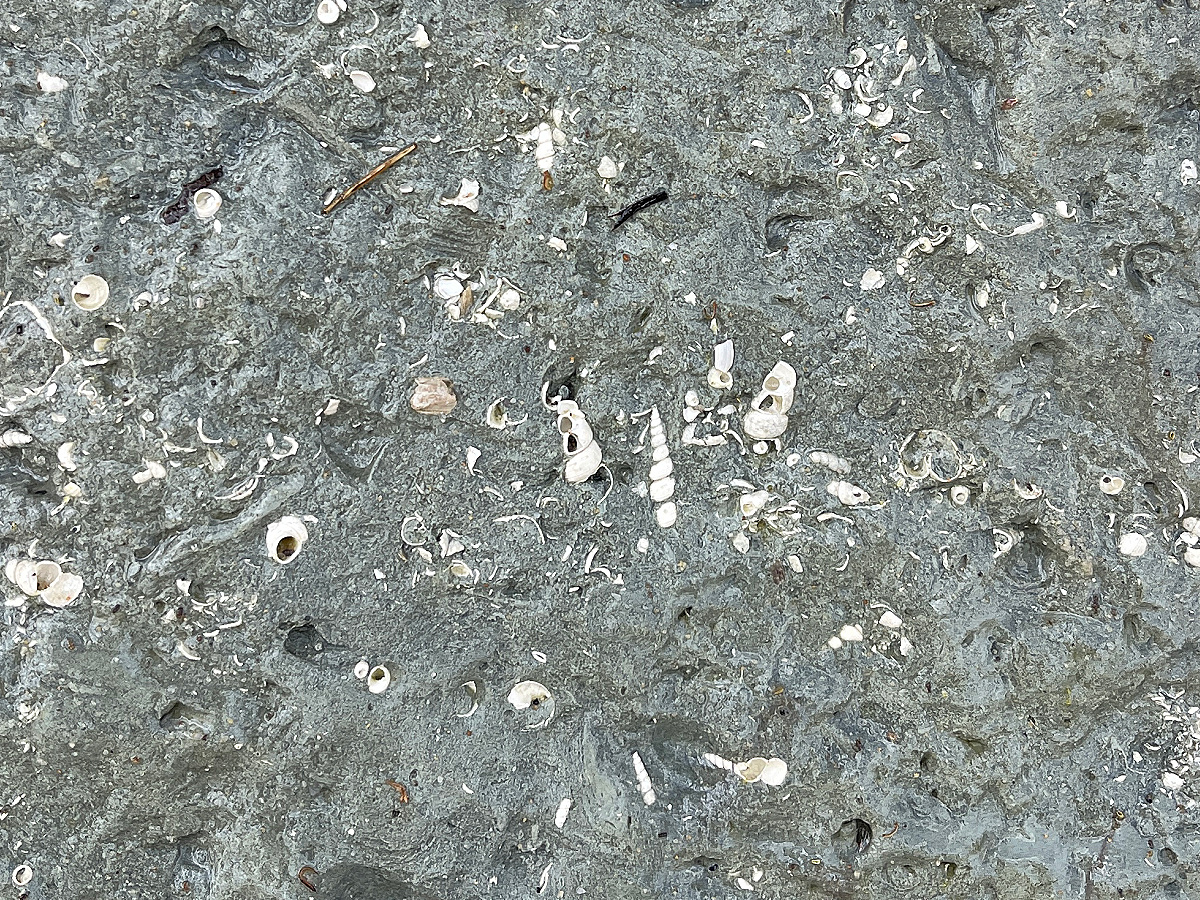
As the seas receded and natural erosion, the remains of the sharks, dolphins, and other aquatic life and vegetation, were trapped and fossilized in the clay and mud layers that now form Calvert Cliffs and much of the coastline in Anne Arundel and Calvert County.
There are hundreds of thousands of years worth of history along the shores of the Chesapeake… and if you are adventurous and curious, you can find evidence of the Miocene Epoch on your next day trip to the Chesapeake!
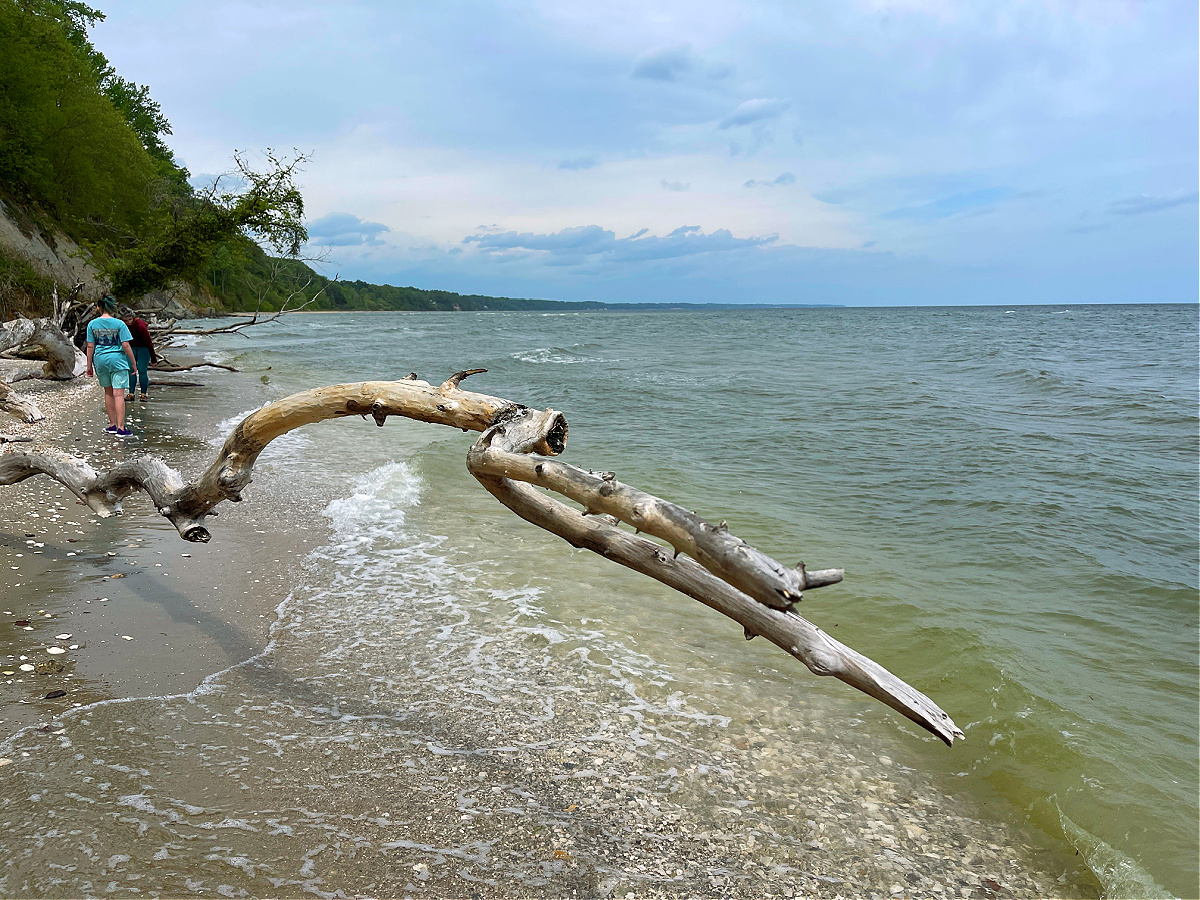
But if there are fossilized remains in both Anne Arundel and Calvert County why are we not able to find shark teeth farther north?
TLDR version: the fossilized remains in Anne Arundel County were a lot easier to get to and many of those fossils were excavated by paleontologists before roads were created further south. Those teeth, fossils, and more are probably in the Smithsonian Museum of Natural History now.. or museums like that.
One of the reasons the Calvert Cliffs and Calvert County area of Maryland is still a great place to go shark teeth hunting is because there literally were no roads to this area of Maryland until the last 50-60 years.
And because of the ongoing fragility of the ecosystem, state, county, and local governments continue to maintain a balance between public access to the coastline and the need to keep this area protected.
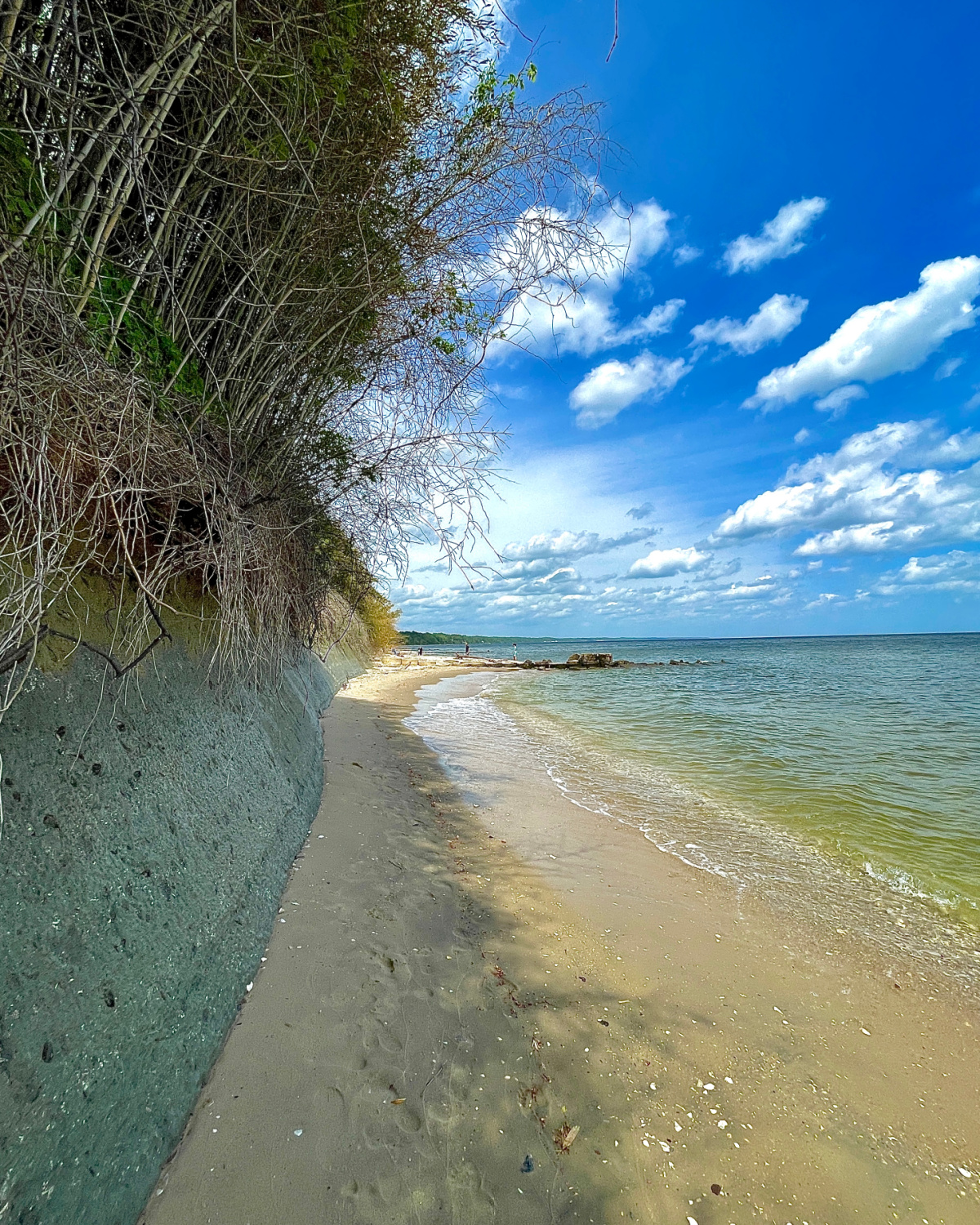
The area from Chesapeake Beach, MD down to Solomons, MD covers three different epochs of geologic formation: Calvert Formation, Choptank Formation, and St. Mary’s Formation.
Related: 100 Days of Summer Fun in Maryland!
Chesapeake Bay Shark Tooth Hunting Tips for a Beginner
We recently went on our first shark tooth hunting trip and it was fantastic! The thrill of finding shark’s teeth and other treasures will bring a smile to everyone’s face.
This is literally one of the best nature scavenger hunts ever! But for beginner or amateur fossil hunters, you might wonder how to go about it. Here are some tips for a beginner, from a beginner.
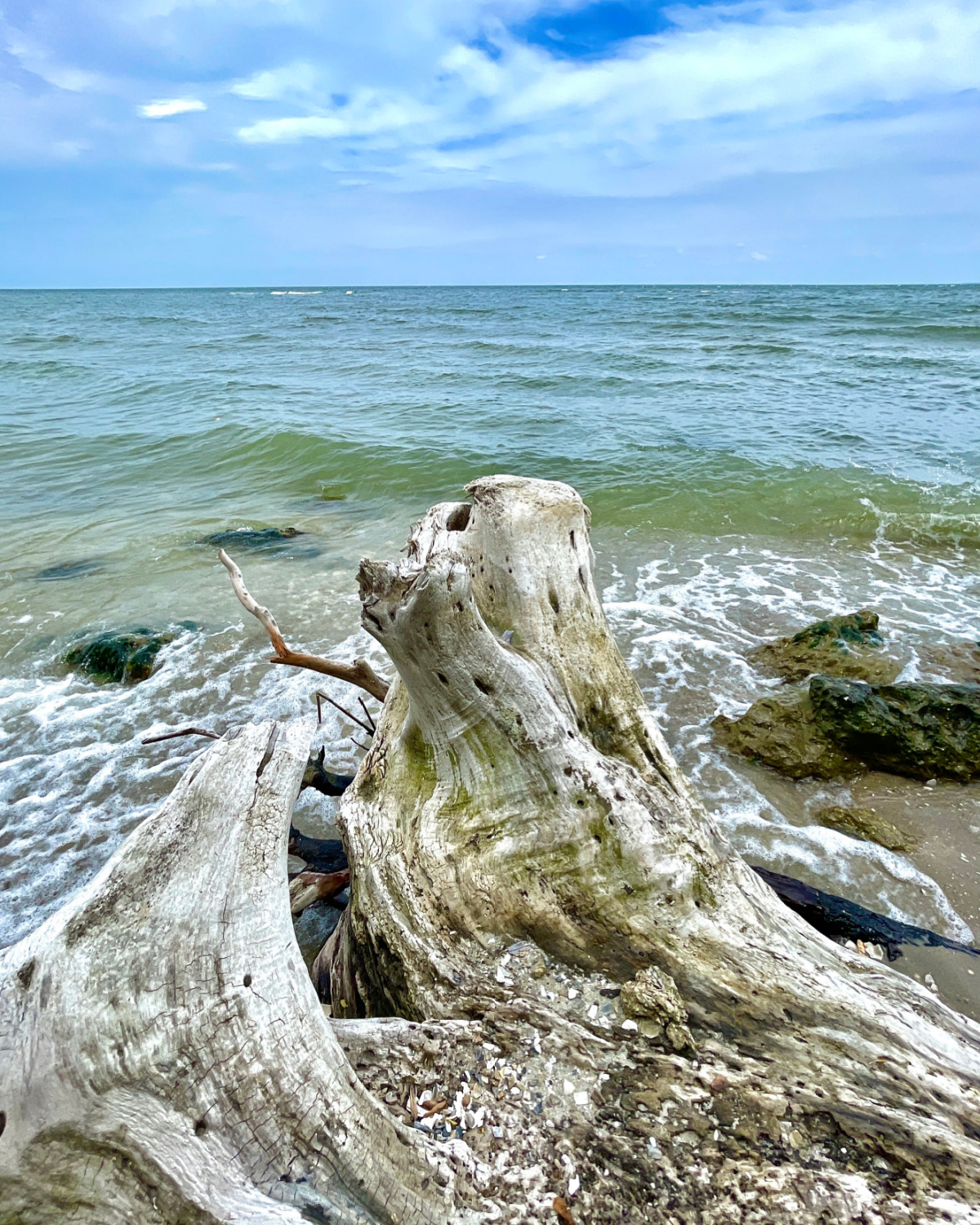
1. Go shark teeth hunting at low tide or as High Tide is Rolling In
As the tide naturally ebbs and flows, it churns up more of the fossilized remains. The best time to sift through newly uncovered treasures will be at low tide or as high tide is rolling in, but not at high tide itself. It’s the same principle with fossil hunting as with shell gathering. You never know what the ocean will cough up onto the shores.
To check the tide tables, click here and search 1. Region: Western Shore of the Chesapeake and 2. Location: Chesapeake Beach (this is for any of the Calvert County locations). Then you choose the number of days you want for the month you are planning a trip, and you can get the tides. I tend to get the tides for the entire month because you might think you want to go shark teeth hunting a particular day– only to find out low tide is at 2AM.
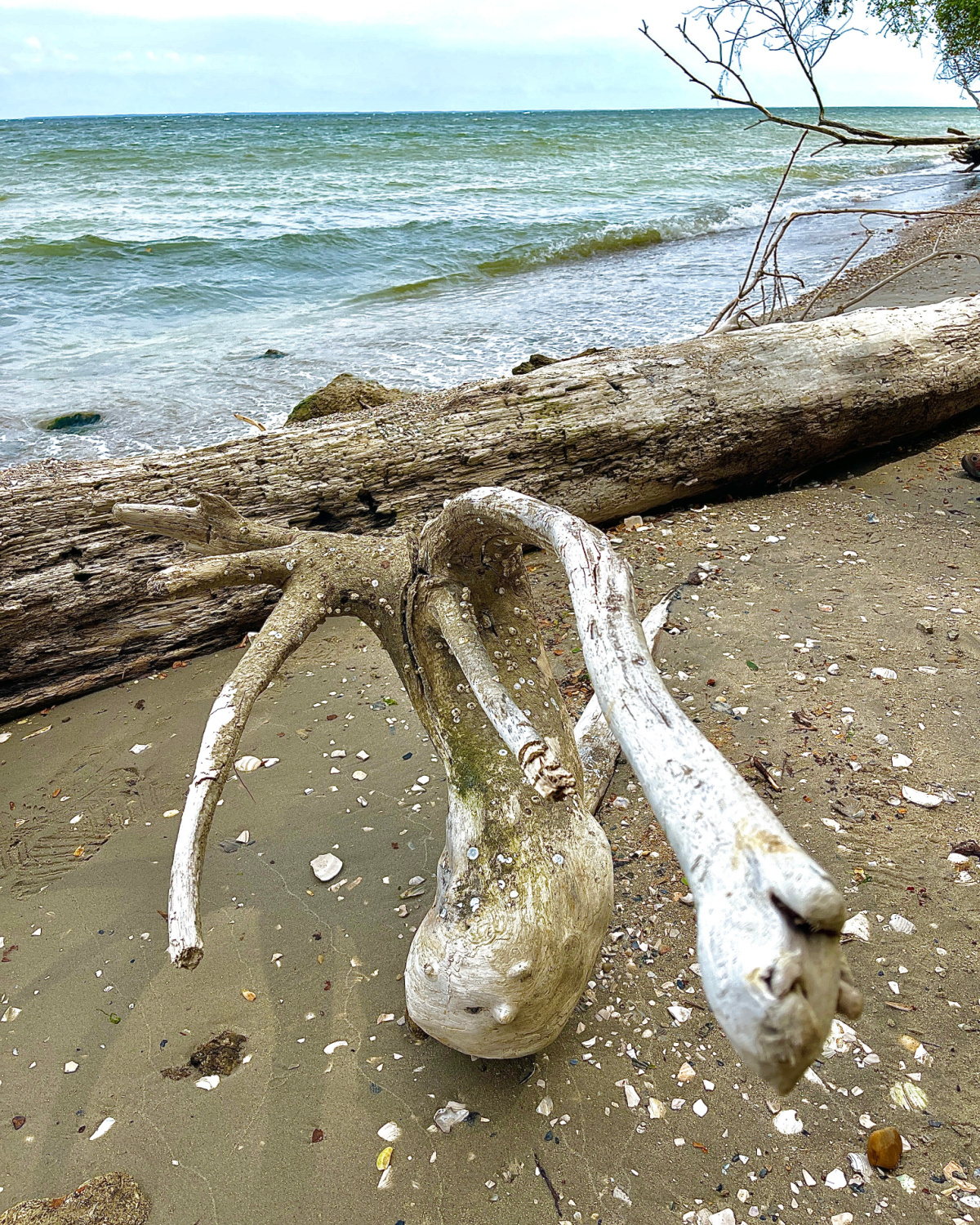
Related: Best Maryland Lakes to Swim in
2. The best time to hunt for fossils is right after a storm. The worst can be right before a storm.
The same principle with shelling applies with this tip as well. During a storm the water is churned up and once the storm is over, you can find some amazing treasures! However, before a storm it is possible the water is choppy, making it harder to see shark teeth and other fossil treasures among the shells and rocks.
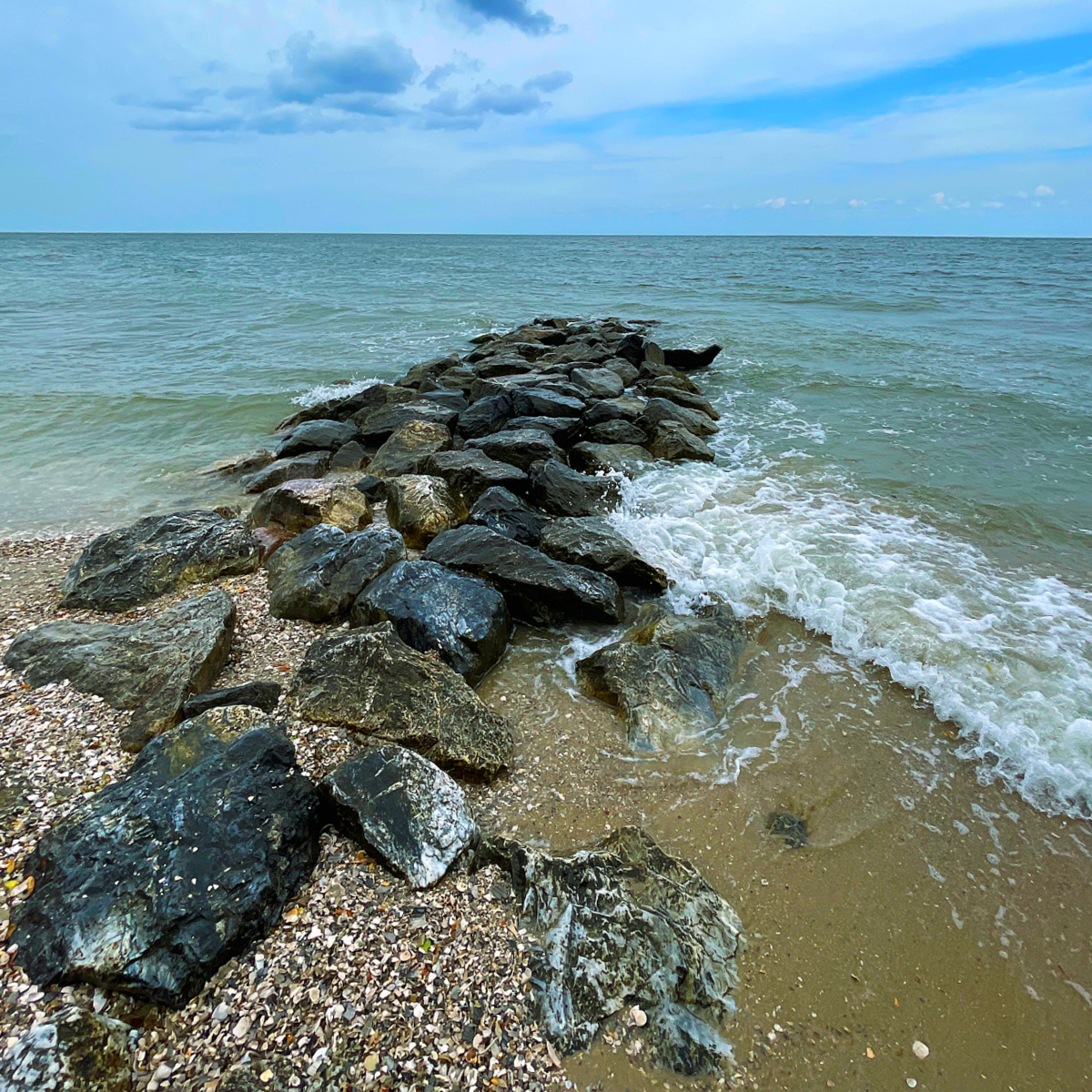
3. There is not a best time of the year to go shark tooth hunting… at least not really.
Basically each season has pro’s and cons. There are more storms that lead to better fossil finds in the winter typically. The girl who recently found the super large tooth of a megalodon, found it on Christmas morning. However, clearly the water is going to be very cold in the winter.
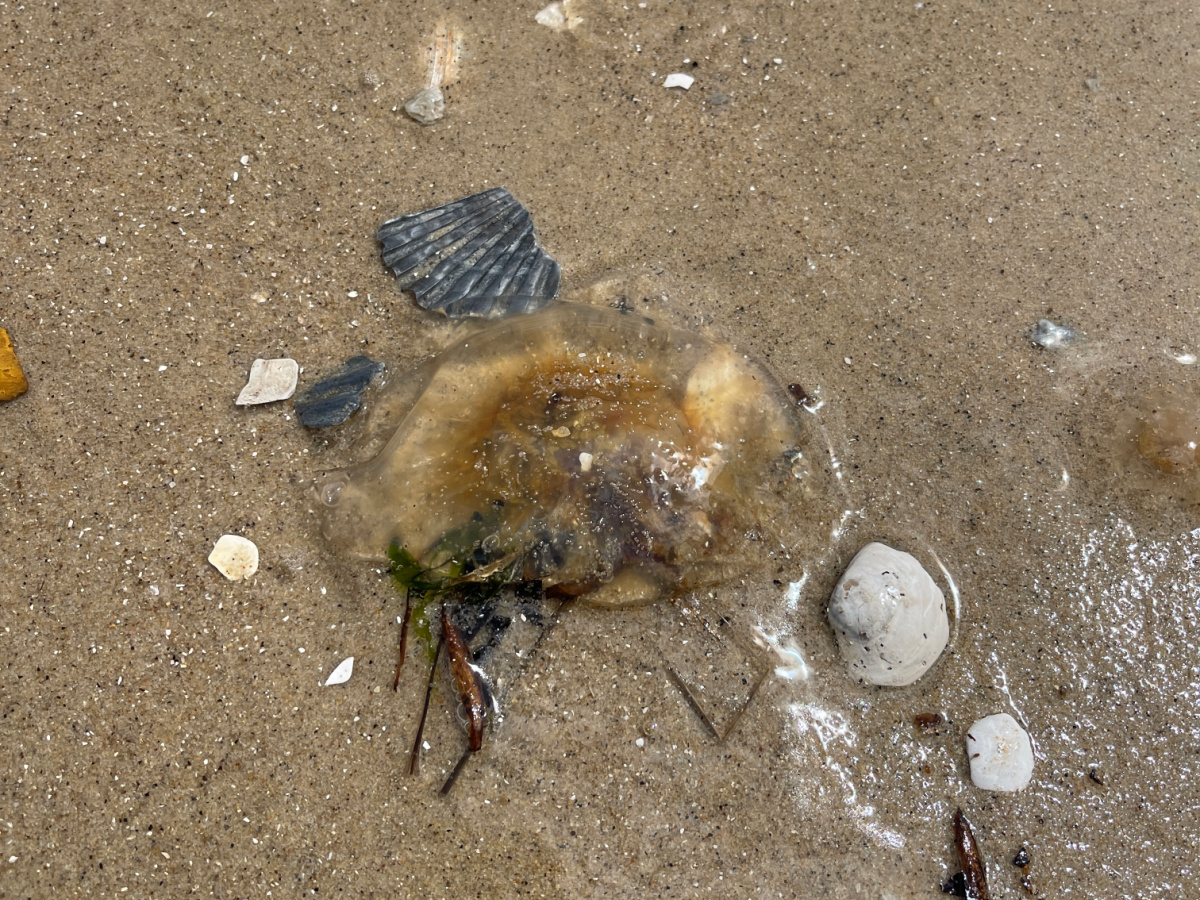
Conversely, the weather will be nicer in the summer but it’s possible you won’t have as good a chance to find bigger teeth. Truth be told though, it’s rare to find a megalodon tooth or a lifetime kind of find at any time and in any conditions.
You can find smaller sharks teeth pretty much all year though. The real reason summer might not be the best time to go shark tooth hunting is actually sea nettles (jellyfish) and a lot more bugs.
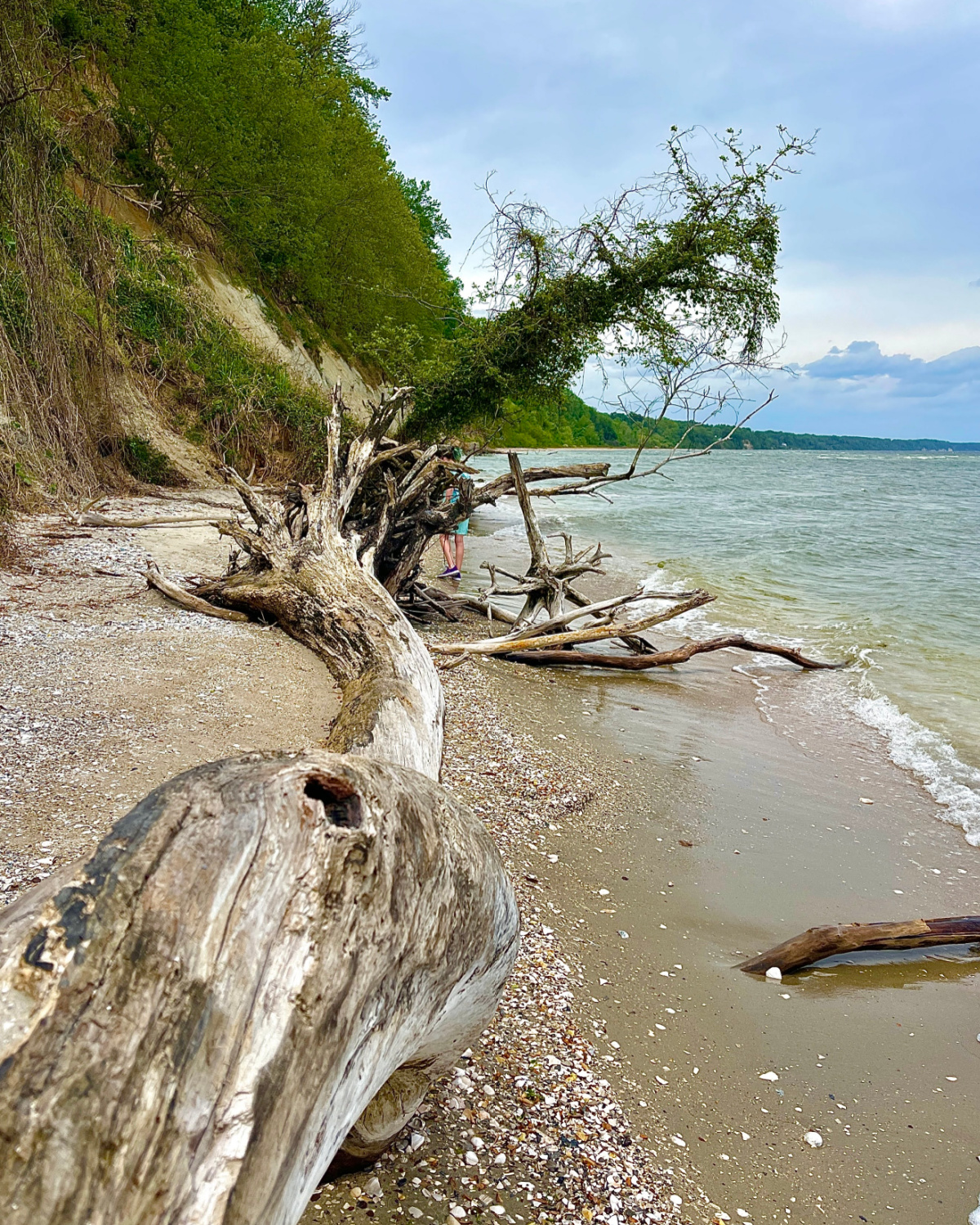
The sweet spot for shark tooth hunting is actually spring and fall. This is when the weather is pretty warm but not hot or cold, but there is still storm activity that could stir up treasures from the ocean floor. Keep in mind though that sea nettles (which arrive around July typically) will stay in the water through October most years.
Related: Annmarie Sculpture Garden is a Southern Maryland Gem!
4. It’s hard to actually see shark teeth if you are a novice, but it’s not impossible.
When we tried shark tooth hunting for the first time, our guide told us it’s much harder to recognize teeth and other fossils unless you have developed the discriminating eye. Ha!
But there are tools that can help you. The tool for shark teeth hunting is actually just a small shovel (like from a kid’s beach toy kit) or a more specialized tool. You will basically be scanning piles of shells along the ‘strand line’, – the line where the tide breaks and leaves the most debris.
You don’t actually have to dig into the sand to find the fossils. Just use your digging implement to scoop up the debris already deposited.
Then look for black shards, even small black shards. It’s likely you will find a lot of shells, rocks, other fossils, and even trash. But if you are persistent you will find shark’s teeth too!
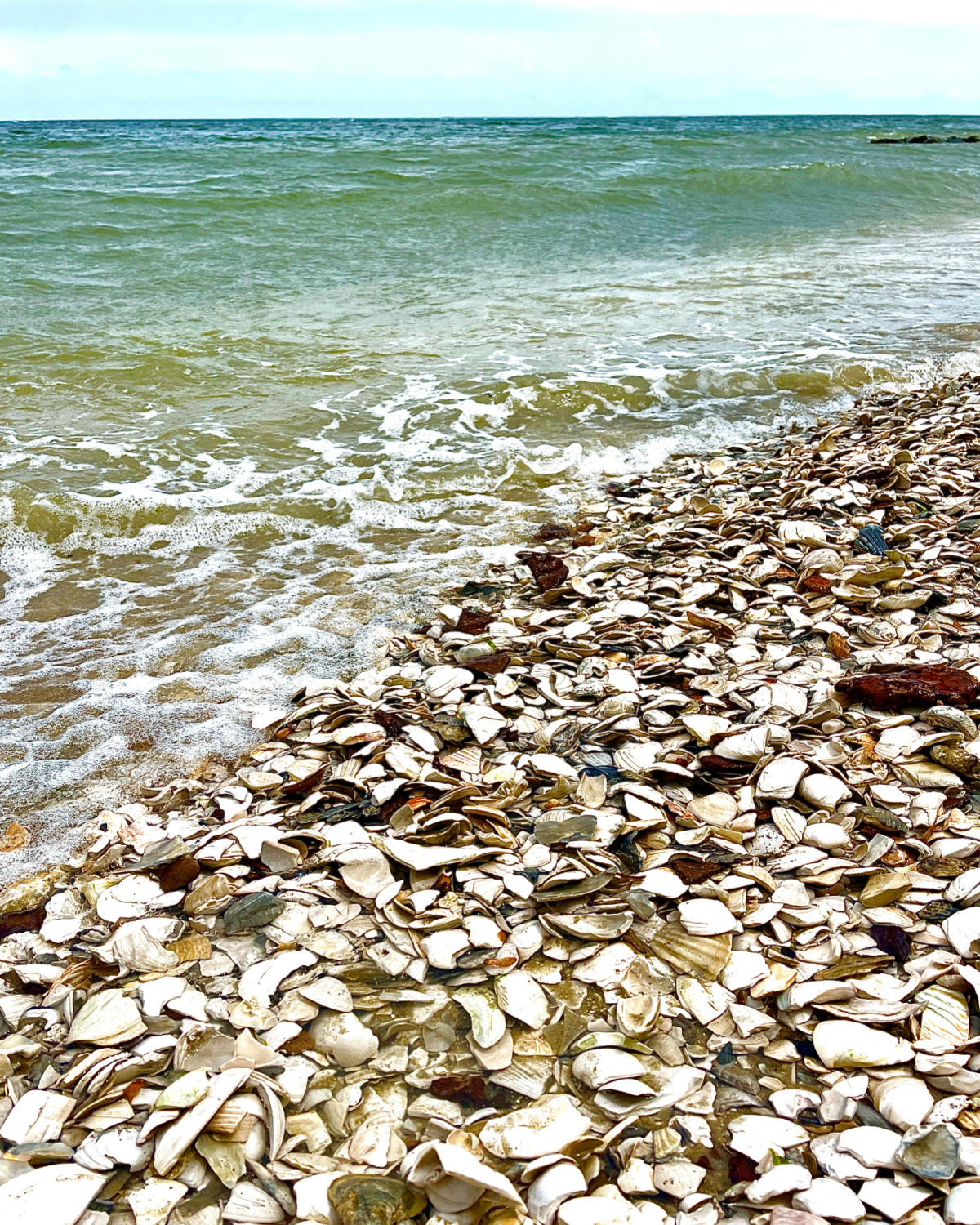
5. Make sure you have the right tools to maximize your experience!
Sunshine Whispers participates in the Amazon Associates and Amazon Influencer Programs. As an Amazon Associate we earn from qualifying purchases. We may earn money or products from the companies mentioned on this site and in this post.
Here are some must have’s for a successful shark tooth hunting trip in the Chesapeake Bay:
- The shovel or debris scooping implement.
- A sifting tool would be helpful. The shovel can do this. But there are fossil sifters that come in many toy beach kits too.
- Sturdy water shoes or water boots. You don’t want to walk on shells and rocks in bare feet. You won’t be wading far into the water, but your feet will definitely get wet. In the winter I would opt for cold-water waders and in the spring and summer, water shoes are probably fine.
- Multiple ziploc bags or small bags to separate and store your treasures. Instead of bringing a big backpack, bring a drawstring bag or beach bag that’s easy to carry. Then bring different ziploc type bags so you can store your treasures. I would recommend multiple bags so you can keep shells and rocks separate from actual fossils you might find.
- You don’t need to wear a swim suit (unless you want to swim) but don’t forget towel and/or baby powder (to get sand off your feet), sunscreen (you can apply before you head out), bug spray (same), sunglasses and/or a sun hat, and water/snacks. We were on our shark teeth hunting adventure for about 4-5 hours. You will be surprised how far along the coast you will wander. Don’t get stuck a few miles away without basic necessities. Just make sure you pack out anything you bring to the beach area.
- Check out some fossil resources before you head out. Fossil Guy is a great places to start!
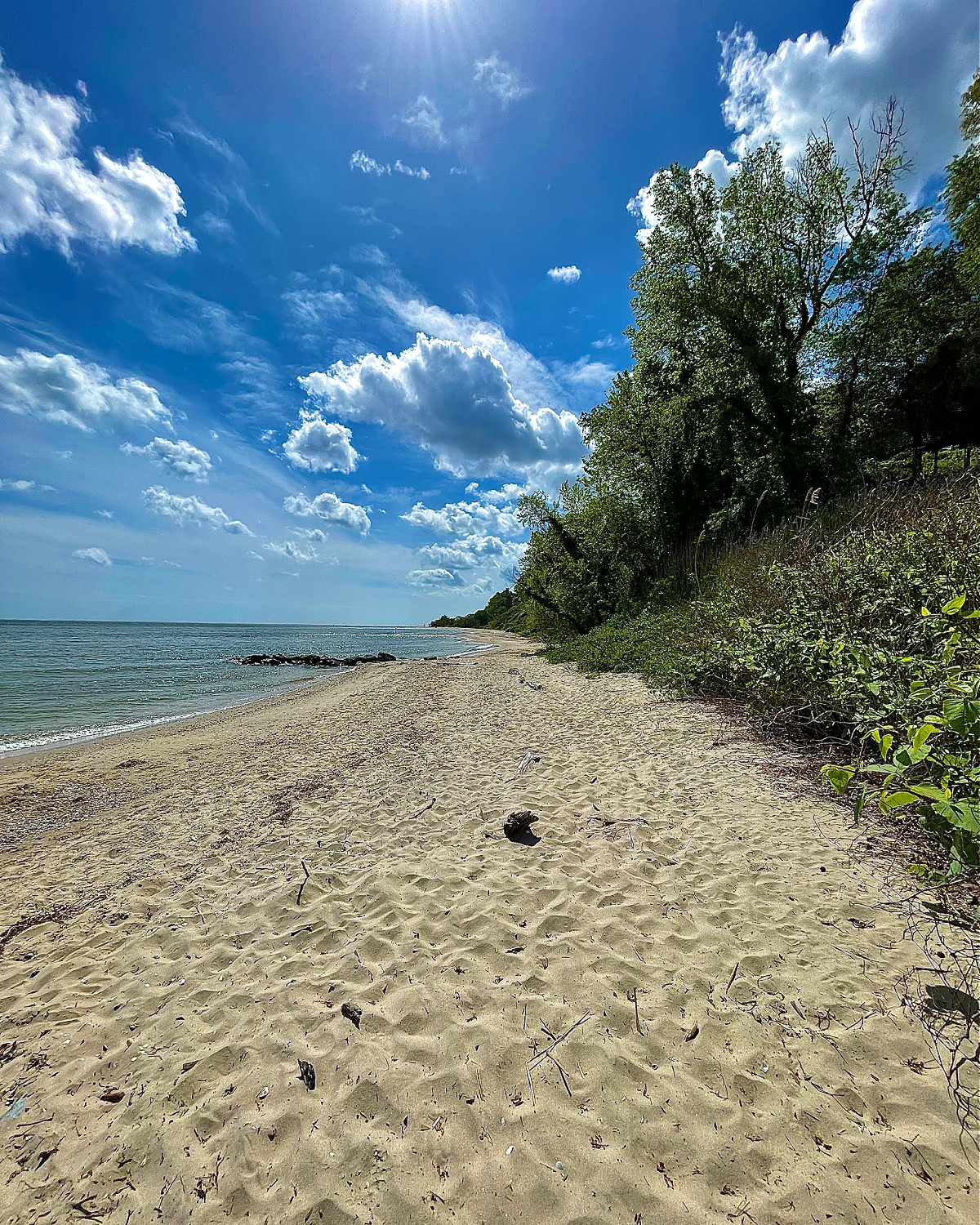
6. Try a guided tour!
Ok, this is actually my best tip! We opted for a guided shark tooth hunting tour with CHAPTours.. and it was amazing! Read my quick review below!
CHAPTours Review- aka, the BEST way to go shark tooth hunting!
When we made plans to go shark tooth hunting for the first time, I knew we wanted to book a tour with Paul at CHAPTours. Paul Murdoch, the owner of Chesapeake Heritage and Paleontology Tours is not just a tour guide, but a certified Chesapeake Bay storyteller (his words.. but it’s true!).
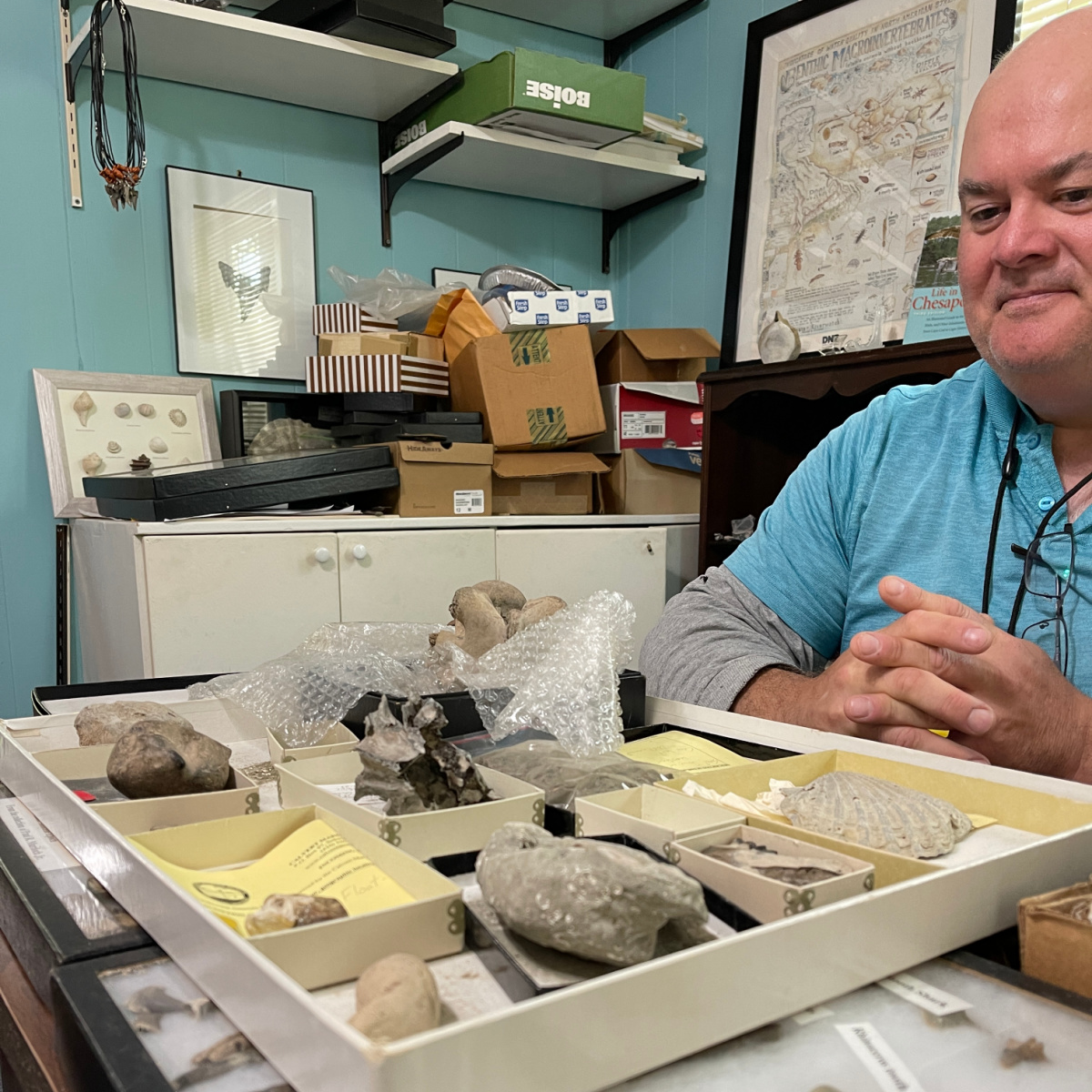
Paul will not only set you up for success by providing some of the tools for shark tooth hunting like those specialized shovels. But he also has access to some of the private beaches along the Calvert Cliffs area.
Paul really is an expert on where to find shark teeth and other fossils, and which beach to visit based on the weather and time of year.
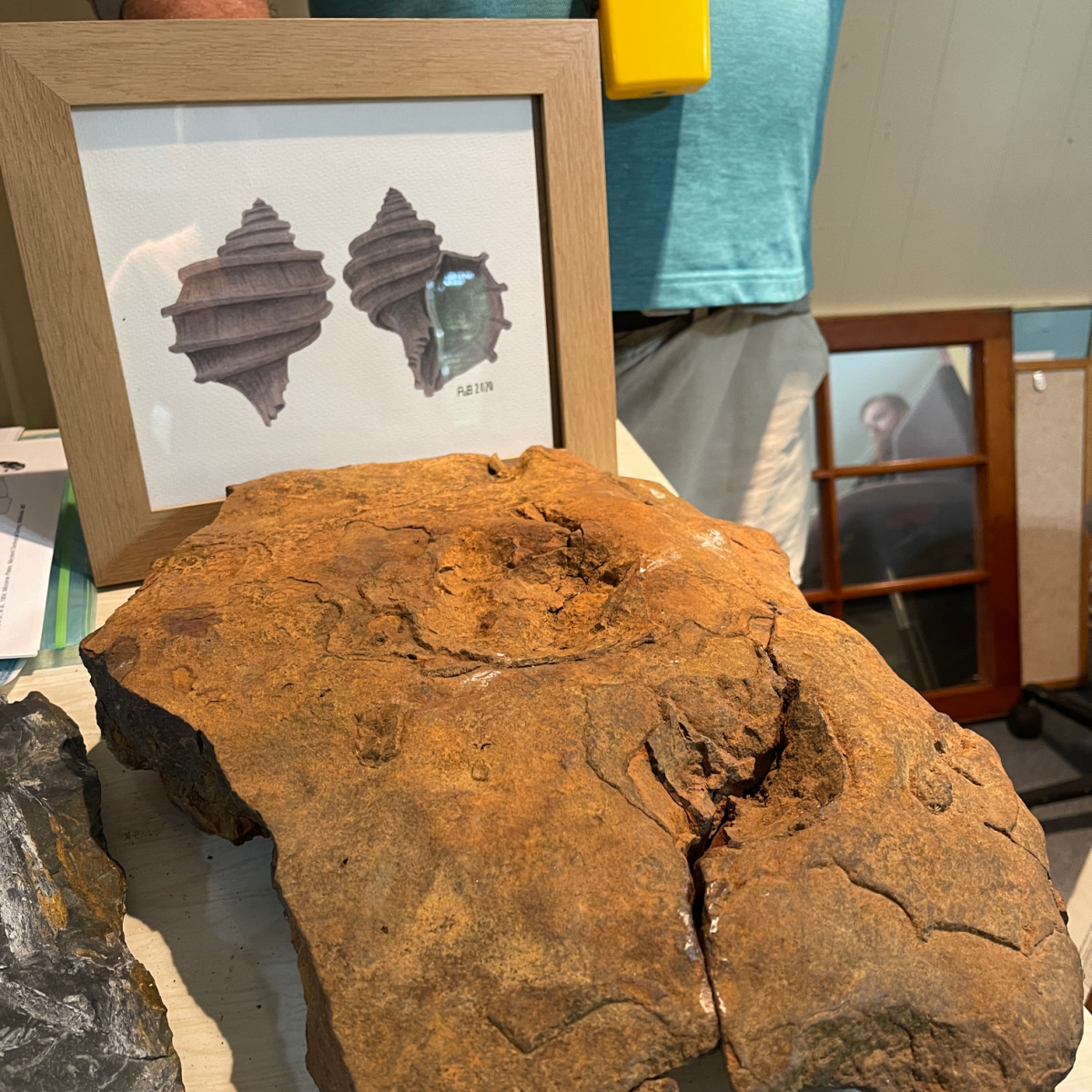
You book your tour online for a 2-hour tour, but that’s just a guide. Our tour lasted well over 4 hours and it was such a phenomenal experience.
Once you book, Paul will tell you when and where to meet. On our tour day, we met at his office in Saint Leonard, MD. From this home base Paul gave everyone a quick history of the cliffs and coastal area. We reviewed some of the fossils left behind by the massive sharks, as well as other species of fossils we might encounter.

From there we followed Paul to a private beach in the area. Everyone parked and changed into beach wading clothes (water shoes)… and we were off!
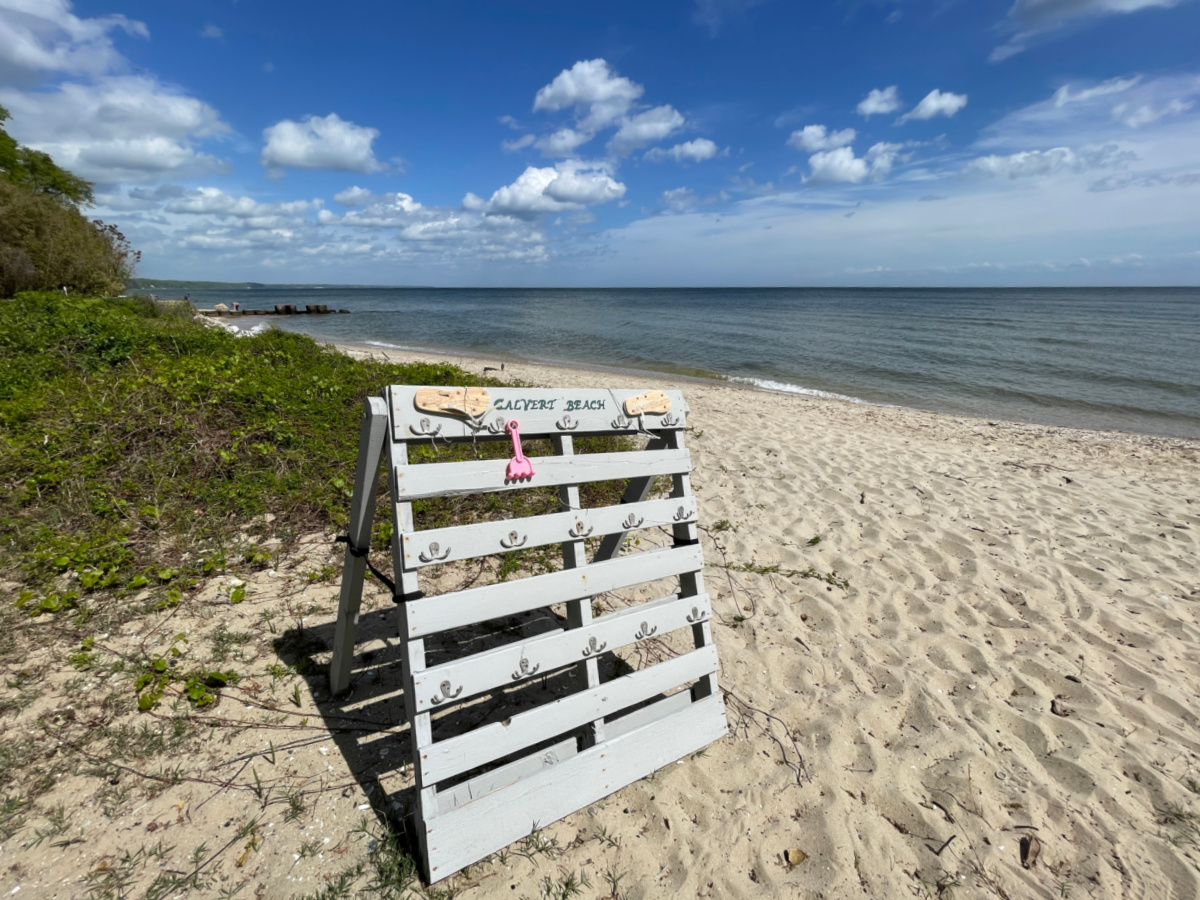
As we started searching for fossils Paul shared so much information about the Calvert formation, tips for fossil finding, other vertebrate fossils we might encounter, and more.
Paul was so passionate about both the history and natural history of the area. He really is a curator of paleontology and he is dedicated to fossil hunts and scientific inquiry.
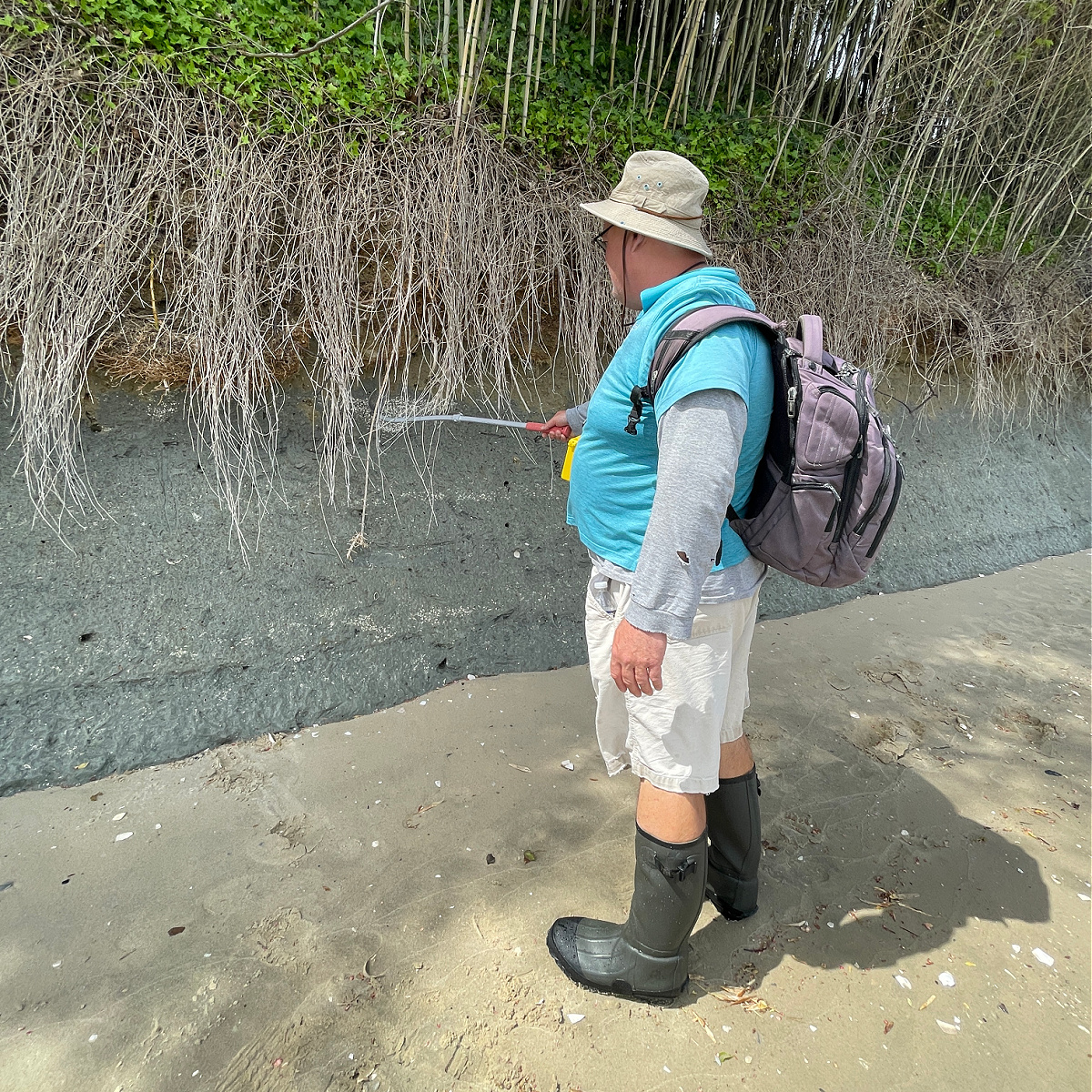
It was so fun to have a guide who was really passionate about paleontology. He explained how the cliffs were formed and he knew exactly what to look for.
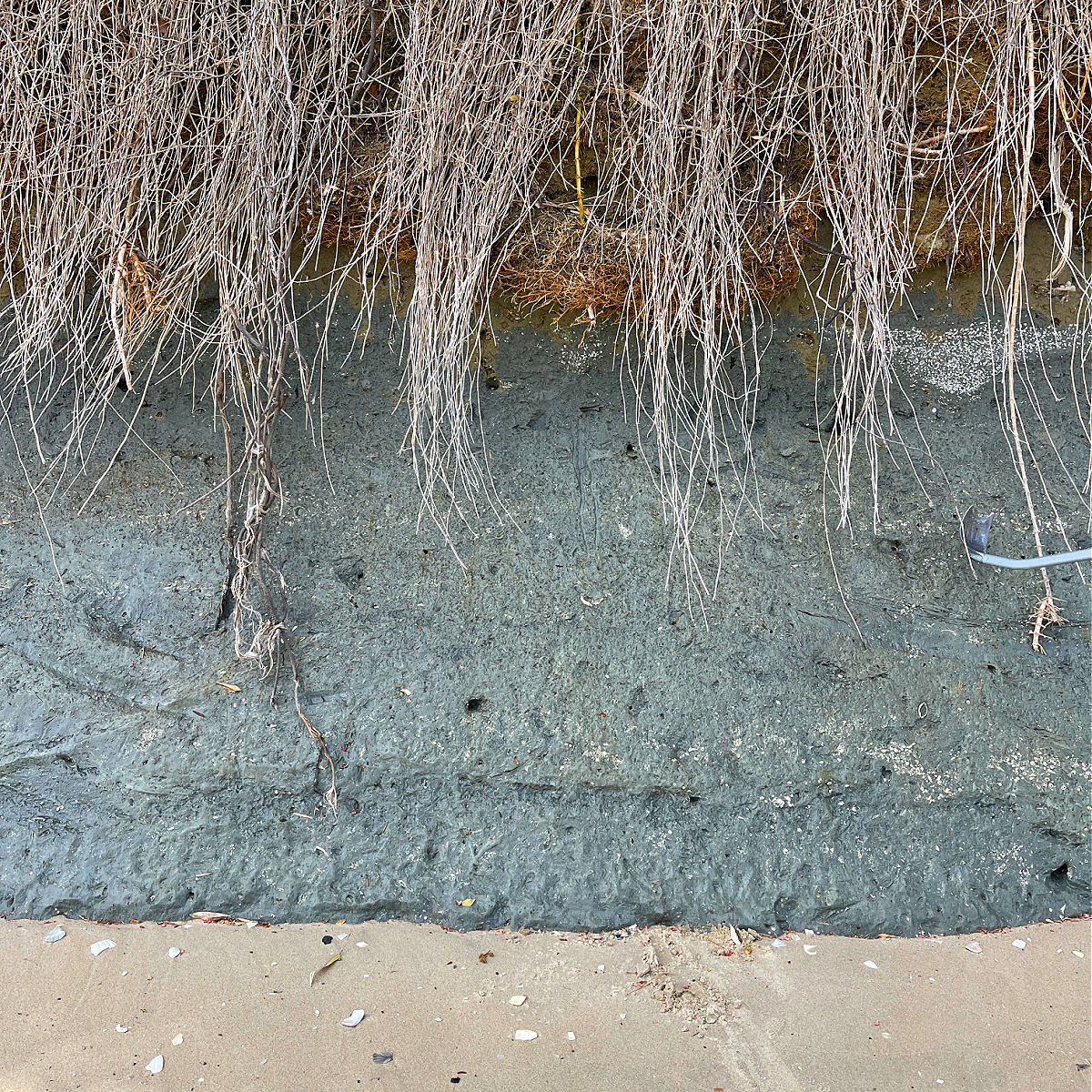
As we found treasures he could immediately tell us if what we found was trash or treasure.
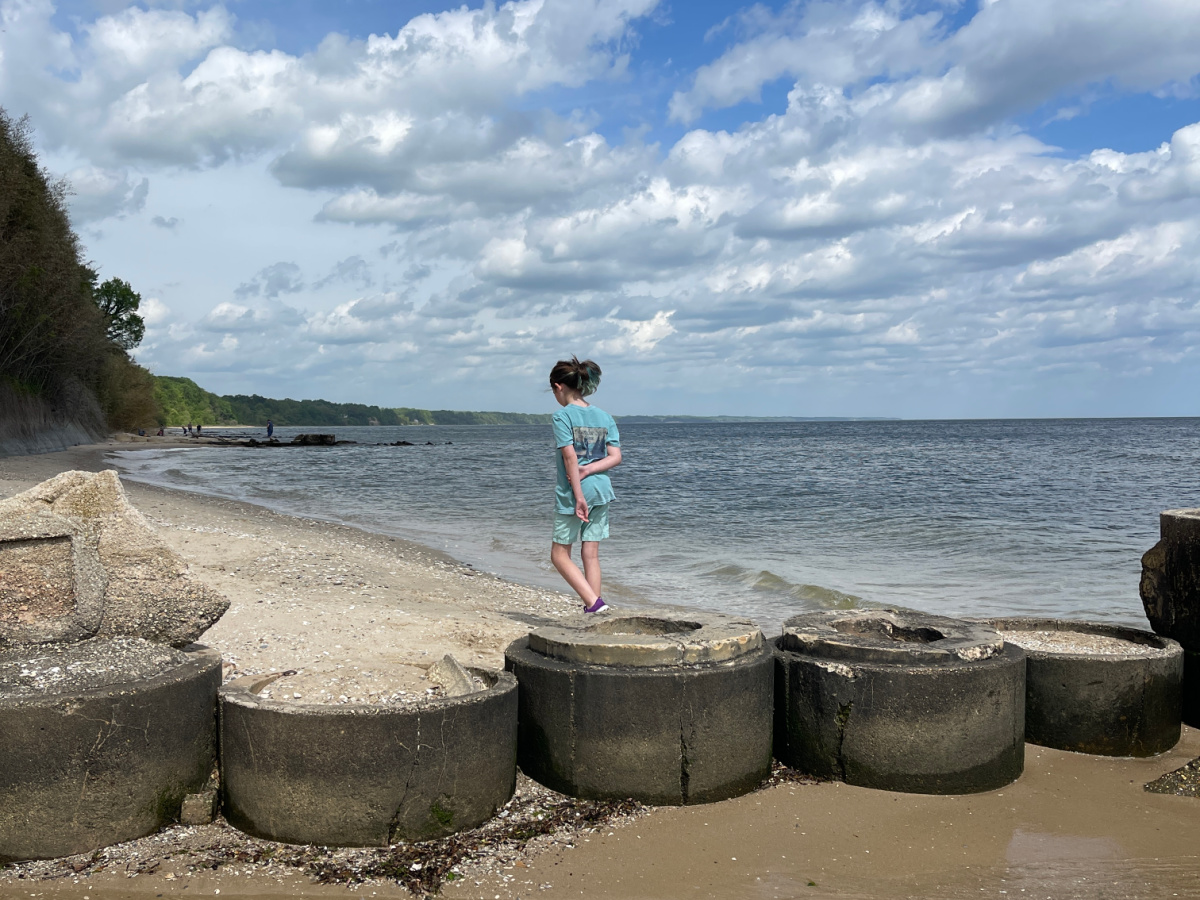
If Paul found a shark tooth he would give our daughter (or us) an assist. We found a fossilized dolphin ear bone on our trip and instead of keeping it, we agreed to donate it to the Calvert Marine Museum. Paul took care of the donation and even offered to donate it in our name! How cool is that?
Click here for more info and to reserve your tour!
5+ Best Places to Go Shark Tooth Hunting in Maryland
If you want to find fossils and shark teeth in Maryland, Southern Maryland is the place to be!
1. Matoaka Beach
If I could recommend only one place to go shark teeth hunting, Matoaka Beach would be that place. There are currently three ways you can access this beach. The easiest way is the pay the $10/person day use fee at the Matoaka Beach Cabins office. They have day use access to the beach path and once you are on the beach you can literally walk for miles along the Calvert Cliffs shore.
The 2nd way to access the beach is to make a reservation to stay at one of their beach cabins or cottages. And the 3rd way is to take a private tour (like CHAPTours) or know someone who lives in one of the private beach access communities along the stretch of cliff from Chesapeake Beach to Solomons.
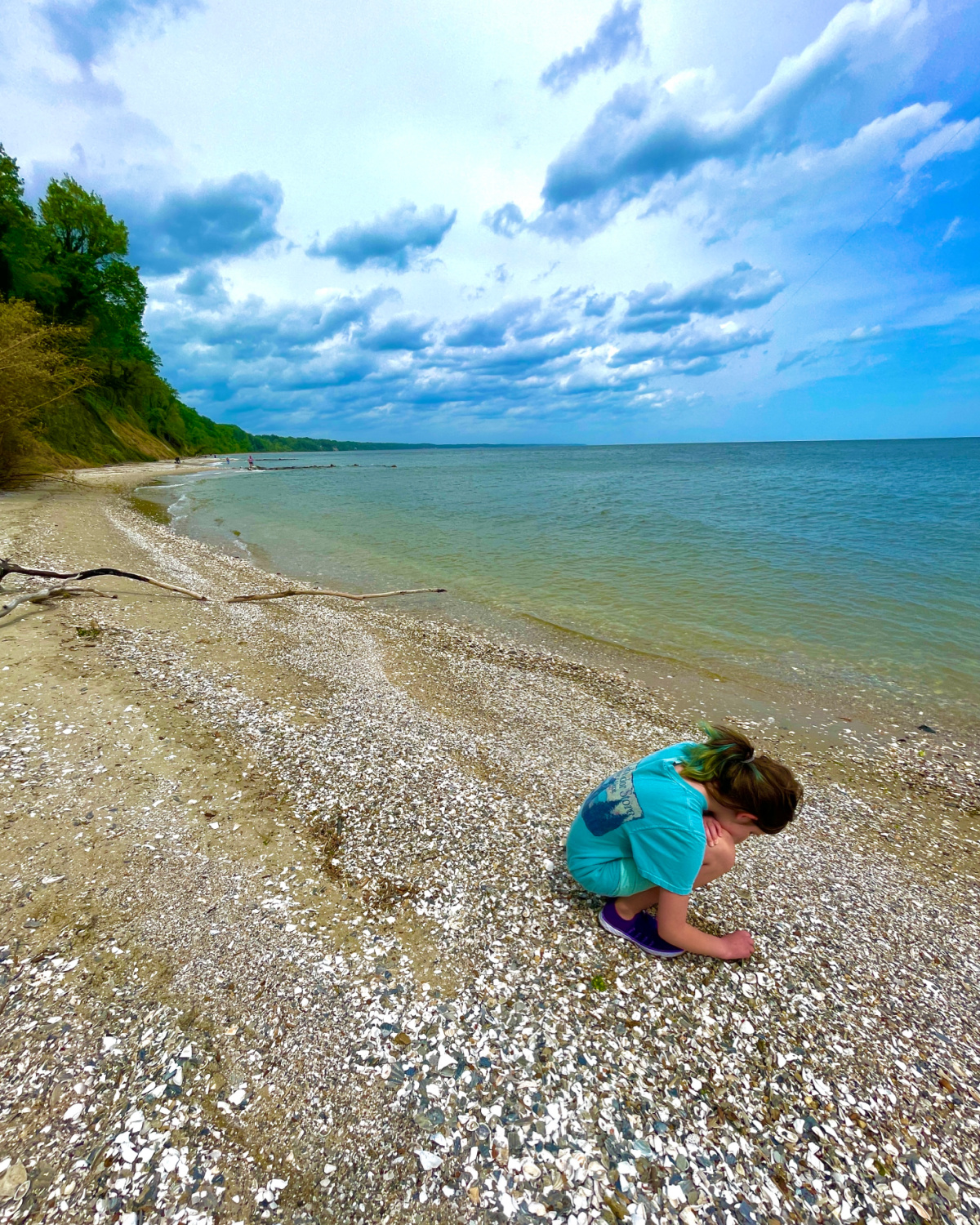
For shark tooth hunting this is the perfect access point. Why? Well, most of the Calvert Cliffs coastline is either privately owned or off limits to visitors. The Calvert County government isn’t trying to deny public access to the area. They are trying to limit public access is an effort to ensure the fragile ecosystem is not destroyed.
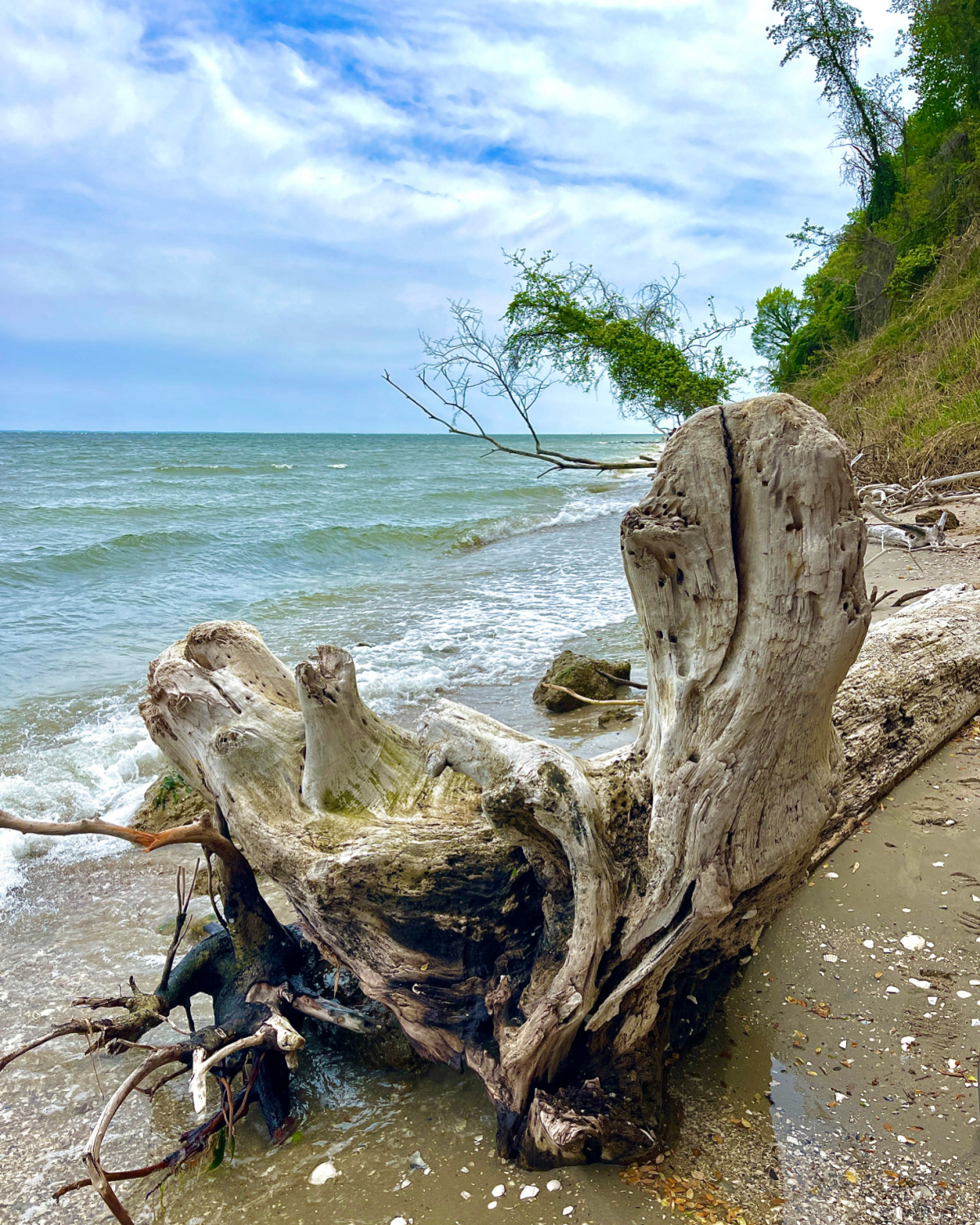
This area can’t handle big groups of people having a beach barbecue and picnic all day. It just can’t. However, the off limits boundary ends at the point of high tide. That means at low tide, aka when you actually want to be on the beach, you can walk anywhere up and down the coast you can physically access. Matoaka Beach Cabins is one of the only access areas that gives you fantastic access to the coastline.
2. Flag Ponds Nature Park
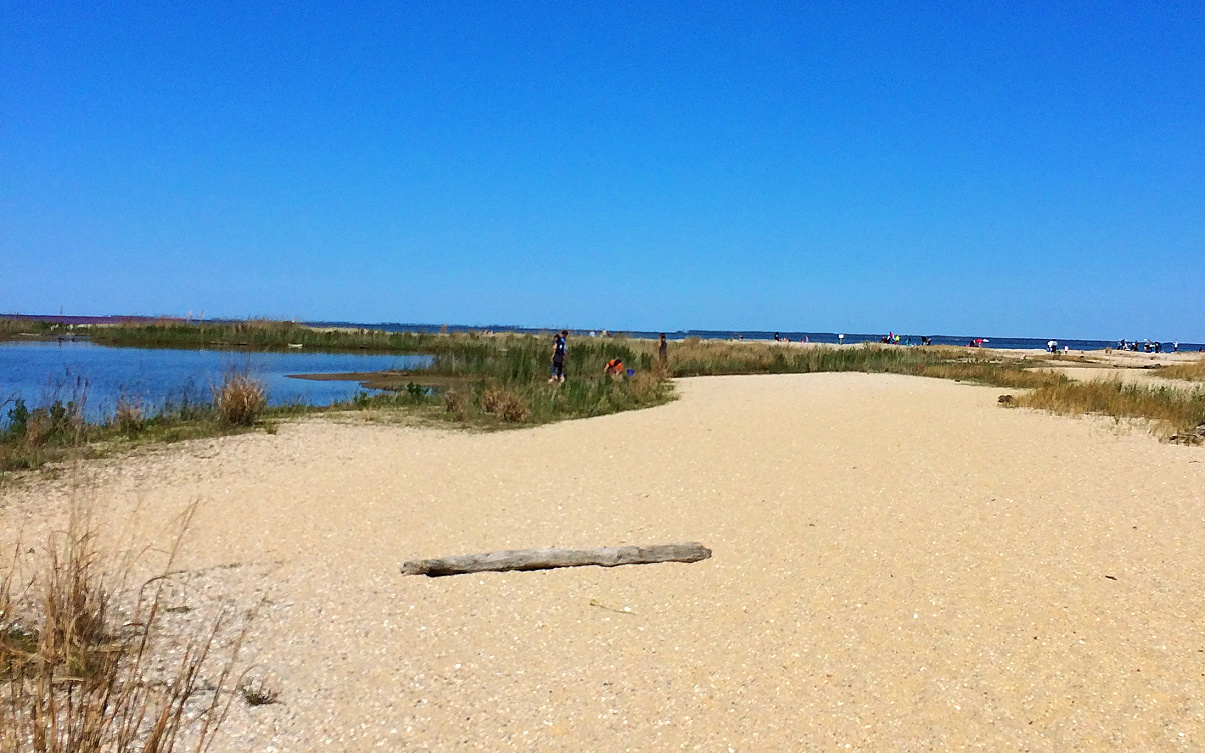
Another great area to access shark teeth hunting is a little further south at Flag Ponds Nature Park. There is a fee charged per vehicle and Flag Ponds has a relatively small parking lot. When this parking lot fills up, they close access to the park. So, if you are headed to Flag Ponds, arrive early!
Related: Read my Review of Flag Ponds here!
3. Breezy Point Beach
Breezy Point Beach and Campground might be a great option if you want to enjoy a beach day with shark teeth hunting on the side. This is a very popular beach in the summer, and it has a playground for kids, netted swimming area (great for jellyfish season), shaded picnic areas, and a campground.
However, if shark teeth are what you are focused on, try to visit Breezy Point in May or June. Why? Well, unlike some of the other areas, Breezy Point is not open during the winter months. It is only open 1 May through 31 October.
That means that in early May there is literally a backlog of debris left over from the winter months. Not only is the weather perfect, but there is a high likelihood of finding loads of fossil treasures!
Like Flag Ponds, Breezy Point will fill to capacity in the summer. If you want to visit, plan to arrive early.
4. Calvert Cliffs State Park
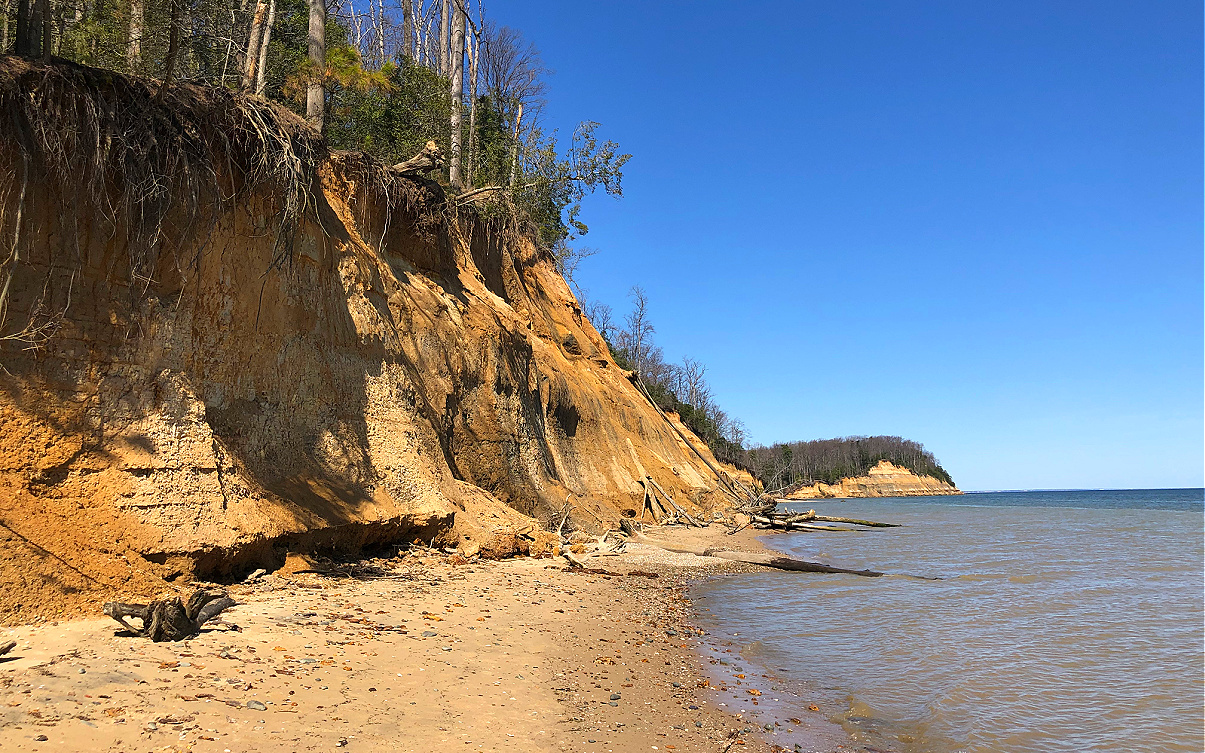
Calvert Beach at Maryland’s Calvert Cliffs State Park used to be considered an excellent place for shark teeth hunting. It is still worth a visit, but because of its popularity in recent years the beach area and access to the cliffs has been reduced significantly.
I would still highly recommend a visit to Calvert Cliffs State Park. The hike out to the beach is quite beautiful, and there is an amazing tire playground at the front of the park.
However, if you really want to collect shark teeth, I might choose a different beach.
5. Calvert Marine Museum
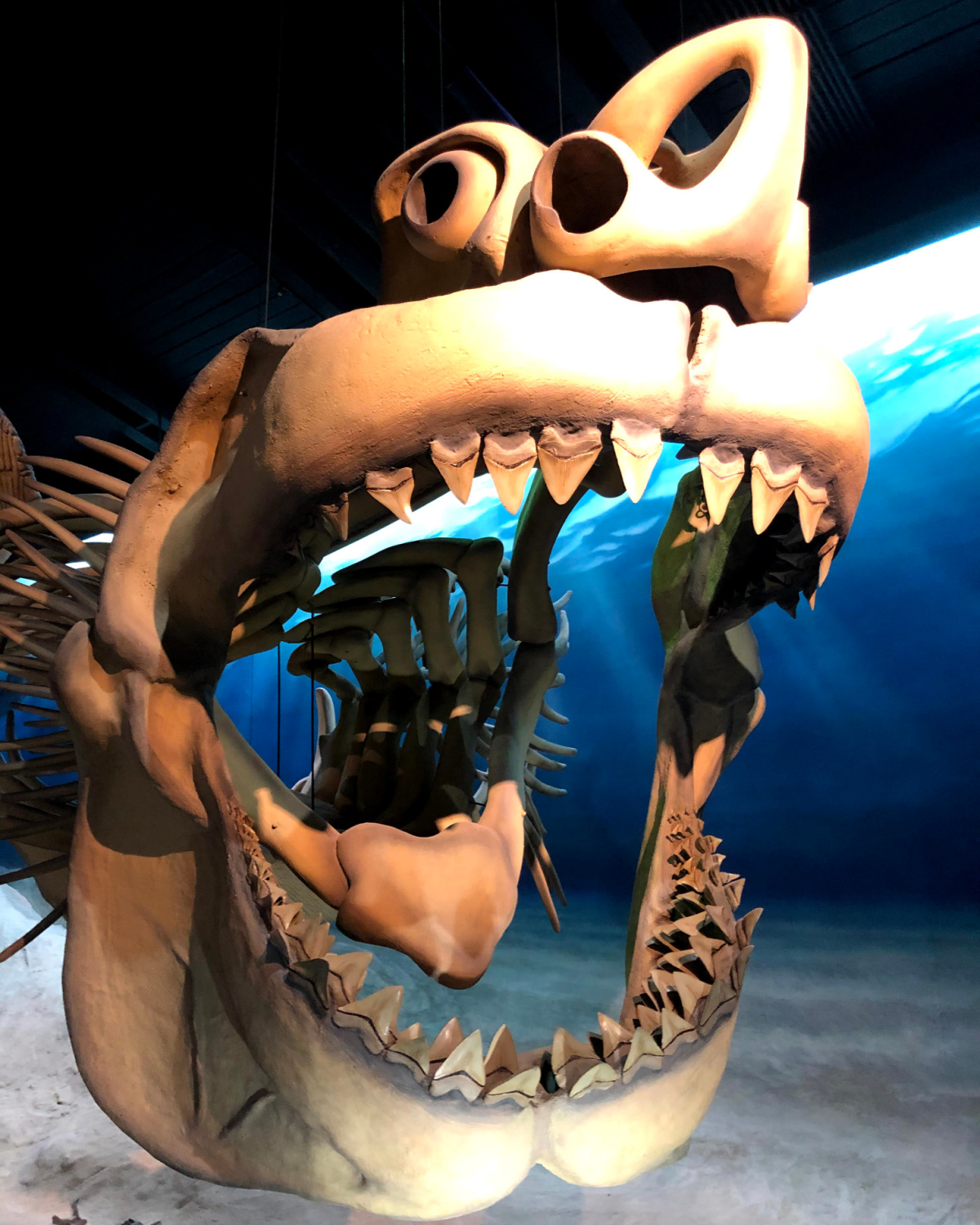
Calvert Marine Museum does not have fossil collecting on site. However, they offer Fossil Field Experience tours at Cove Point about 6 times a year. This is a tour similar to the CHAPTour because a paleontologist provides an orientation to fossil finding and then after you explore the area, the museum will help you identify your treasures.
Also, the Calvert Marine Museum is an amazing museum for kids and if you have a young paleontologist, they would love to learn more about fossils here. They have some of the largest megalodon teeth on display anywhere.
Related: The Kid Friendly Guide to Calvert Marine Museum
6. Purse State Park
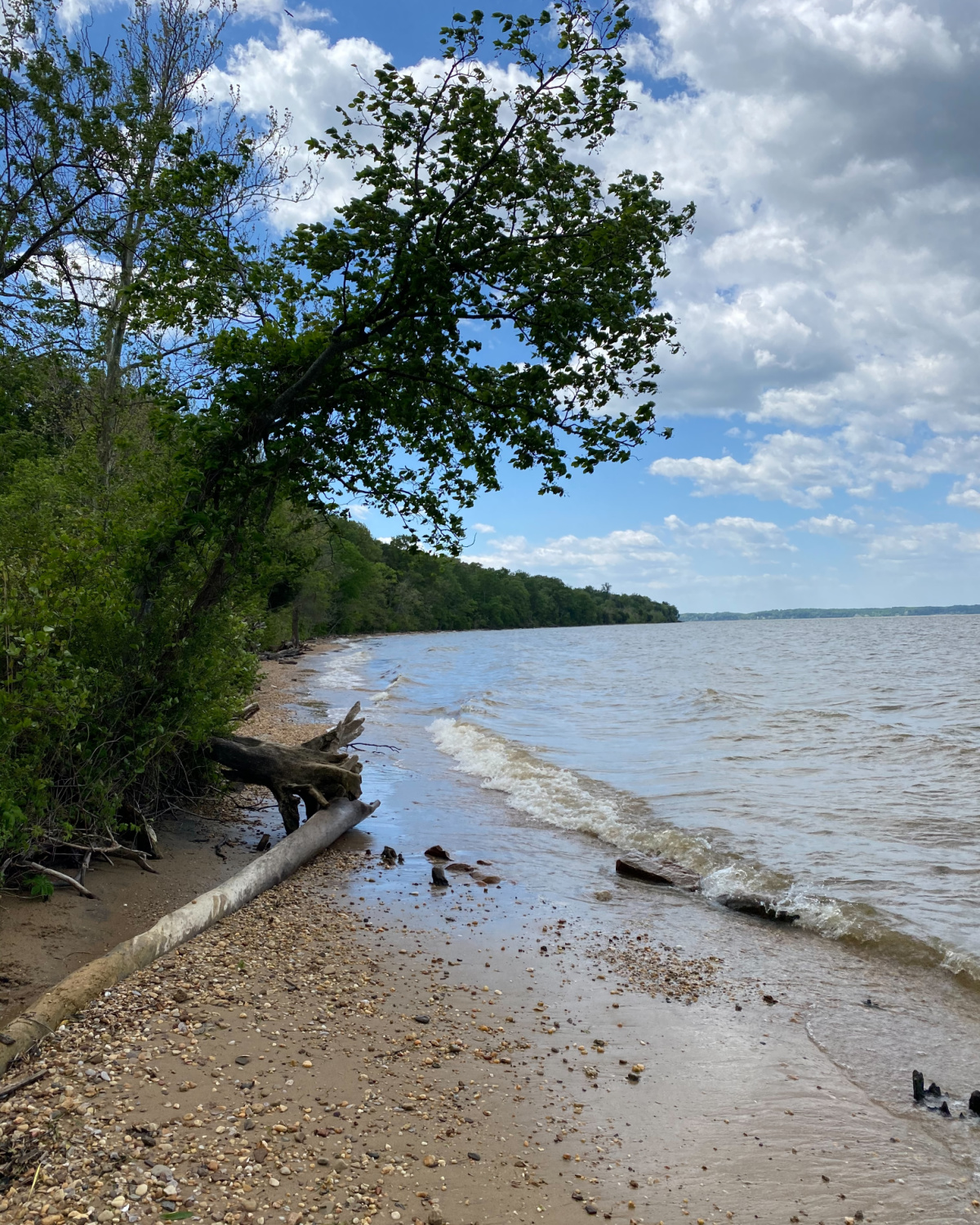
Actually, Purse State Park is not a state park anymore. It is now part of the Nanjemoy Wildlife Management Area in Charles County, MD. Shark teeth hunting here is not the same experience as on the Chesapeake Bay. But there are still loads of shark teeth that wash up in the shallow waters of this Potomac River side beach.
Click here for Google Map Directions to the Driving Area.
This park area and beach is one of the best places to hunt for shark’s teeth and fossils and is definitely a hidden gem of Maryland. That is actually the big draw! The beach itself is nice but super small.
Park across from the trailhead and hike the short walk (1/4 mile) to the beach.
Before you head out, be sure to check out the tide table and arrive either before or after low tide! Note: the tide will be different for this beach vs. the Chesapeake Bay beaches. For the tide tables, search– Potomac River/Liverpool Point, MD
7. Bayfront Beach Park (Brownies Beach)- currently closed for non-residents
I can attest that Bayfront Beach Park is an amazing beach. Like Matoaka Beach, this is wild Maryland at it’s finest. Unfortunately as of 2020, the beach is closed to anyone who isn’t a resident of Chesapeake Beach, MD. I think one of the biggest reasons for the closure is the fragile ecosystem.
And even though that is certainly a great reason to close access to most of the public, it still stinks. Fingers crossed that the public access will open again in the next year or so!
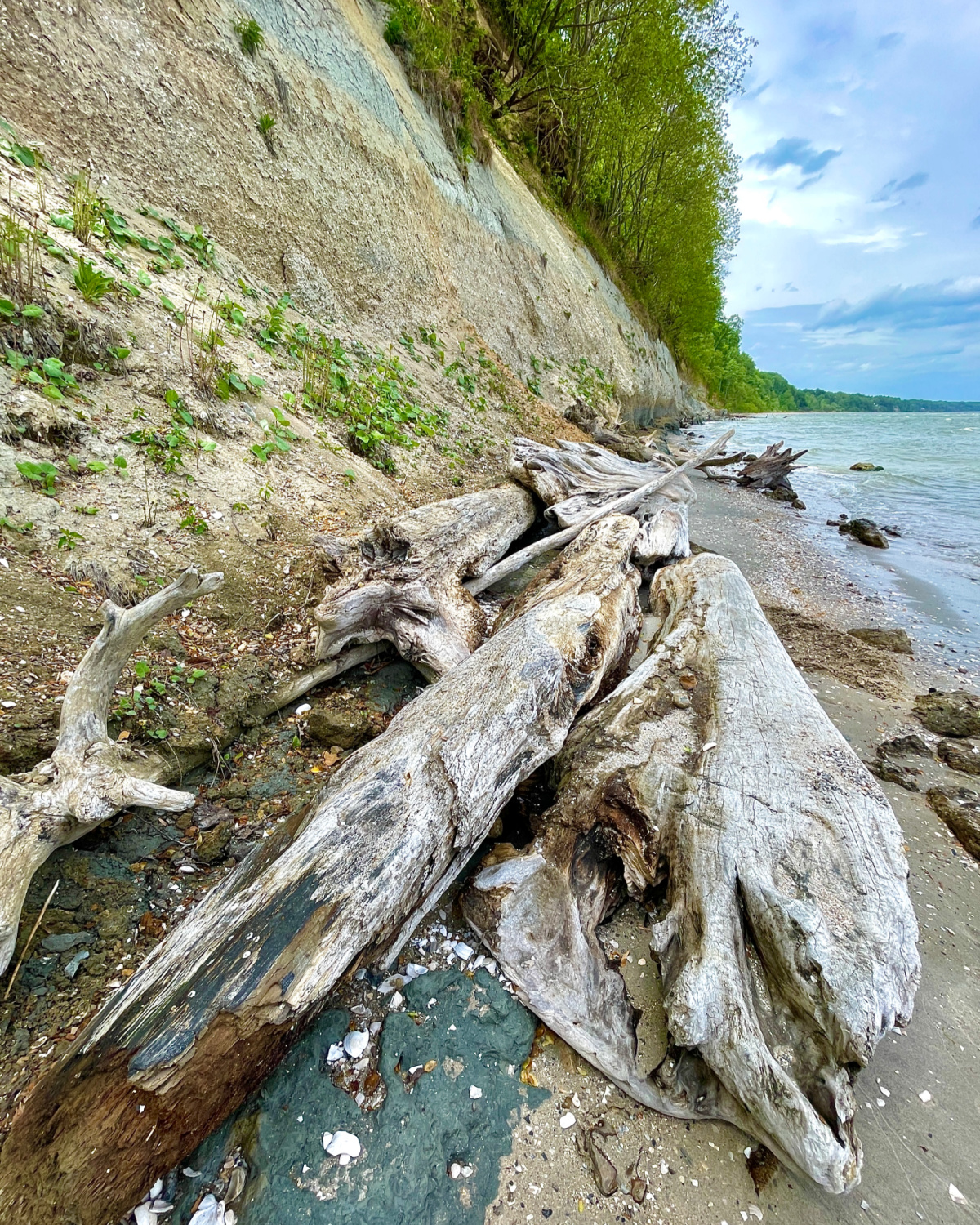
FAQ
The Chesapeake Bay used to be under water during the Miocene Epoch, about 17 million years ago. This area is thought to be the calving area for the Megalodon shark. As the waters receded and the cliffs eroded, the teeth fell from the eroding cliffs around the Bay. Now they regularly wash up on shore.
The best place to find shark teeth in Maryland is the Calvert Cliffs area, but not necessarily Calvert Cliffs Beach. Try Matoaka Beach, Flag Ponds Nature Park, or Breezy Point Beach.
1. Pick a beach known to have fossils. 2. Check the strand line (where the tide breaks and leaves debris). 3. Look for jet black items among the piles of shells and rocks. 4. Shark teeth are smaller than you think. Don’t discount small. 5. Don’t think about only shark teeth. There are likely ray and dolphin fossils, as well as alligator and vegetation fossil imprints.
Megalodon teeth are the rarest shark teeth to find. You will likely find smaller shark teeth, but large Megalodon teeth are extremely rare to find.
After a storm because the waves will have exposed new layers of sand. However, any time of the year is a good time to find shark teeth.
Day or night does not matter as much as low or high tide. The best time of day to find shark teeth is after low tide as the high tide is rolling in. Check shell beds as the high tide is rolling in and depositing treasures among the shell beds.
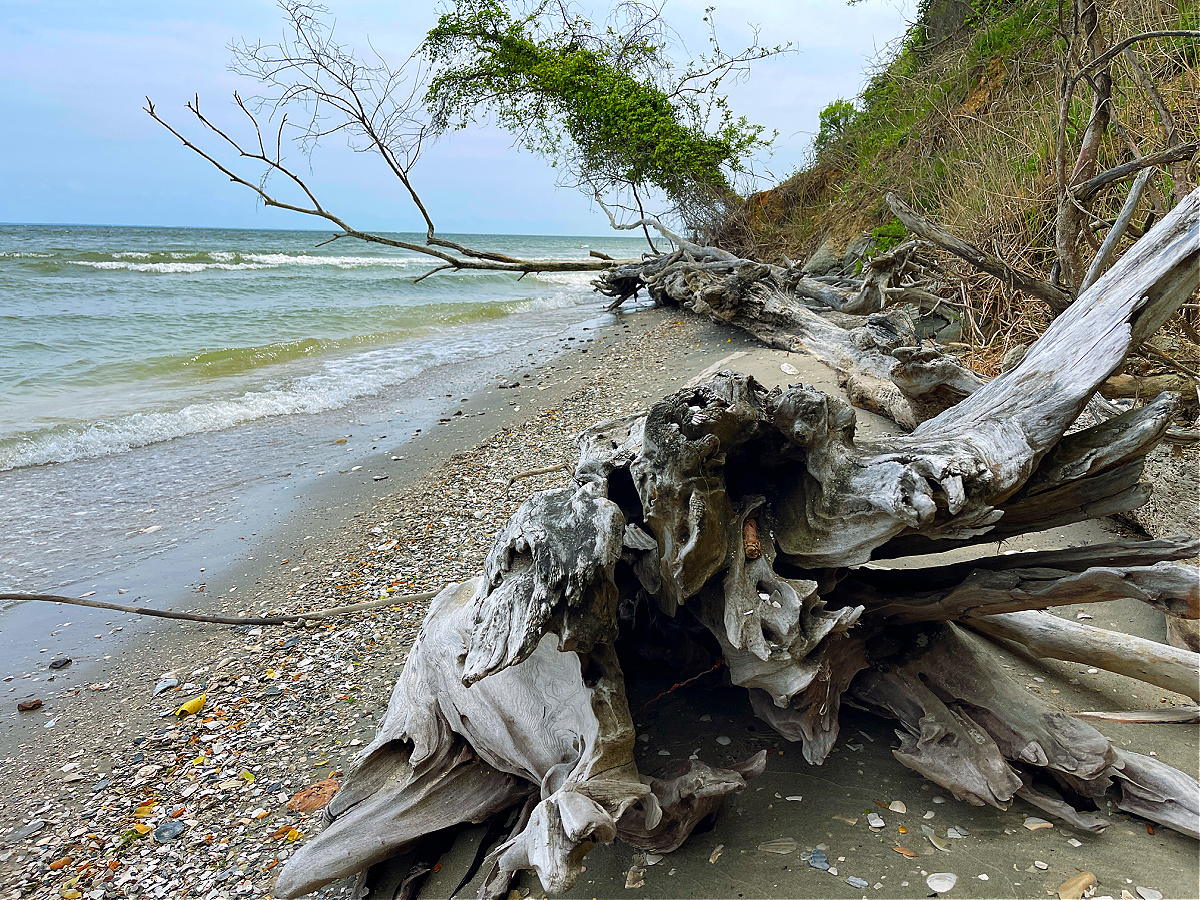
Pin for Later!
